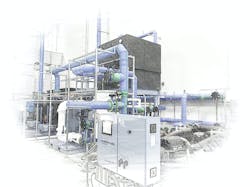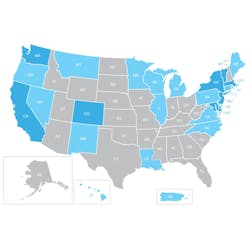Sustainable solutions: Navigating the green transition for chillers
Amid escalating environmental concerns about refrigerants and their substantial contribution to the Greenhouse Effect, global governments are actively implementing regulations to phase out high Global Warming Potential (GWP) refrigerants. This article provides insights into the evolving regulatory landscape, highlighting the recently finalized Technology Transition Rule by the Environmental Protection Agency (EPA). It explores the profound impact of these regulations on manufacturers and delves into the strategies employed by the industry to navigate these challenges.
Global warming potential serves as a metric to assess the atmospheric impact of greenhouse gases, measuring their capacity to absorb infrared thermal radiation over a specified time frame. This metric is expressed as a multiple of the radiation absorbed by an equivalent mass of added carbon dioxide (CO2). Hence, the GWP for CO2 is 1. For other gases it depends on how strongly the gas absorbs infrared thermal radiation, how quickly the gas leaves the atmosphere and the time frame being considered. Illustratively, Propane (or R-290) exemplifies a GWP of 3, indicating its contribution to global warming is approximately three times greater than that of CO2. Another pertinent example is R-410, a widely used refrigerant in industrial chillers, boasting a GWP of 2,088. It is noteworthy that many of these high-GWP refrigerants fall under the category of hydrofluorocarbons (HFCs).
Governments worldwide are employing a variety of strategies to alleviate the environmental impact of refrigerants, creating a framework for the gradual phasing out of high-GWP or HFC options. As an illustration, in 2016, the EPA introduced the Significant New Alternative Policy (SNAP) 21, aiming to prohibit high-GWP refrigerants in new chillers by January 1, 2024. Due to legal challenges, this ruling was withdrawn, leading individual states, including California, to enact their variations of SNAP 21. Presently, 12 states have implemented legislation to begin restricting the use of high-GWP refrigerants in chillers, effective on January 1, 2024. The EPA's recently finalized Technology Transition Rule restricts the use of HFCs by sector nationwide. It categorizes the regulation of high-GWP refrigerants in chillers into five distinct subsectors. Industrial process chillers with an exiting fluid below -58°F are exempt from regulation, while process chillers operating between -58°F and -22°F must comply by January 1, 2028. Chillers operating above -22°F have an effective date of January 1, 2026.
Chiller manufacturers are strategically searching for alternatives to high-GWP refrigerants in alignment with evolving regulations and environmental objectives. Notable refrigerants that will not meet the new GWP limits include R-410A, R-407C and R-134a. Several alternatives fall below 700 GWP, each with their advantages and drawbacks. R-513A serves as a suitable substitute for R-134a, exhibiting comparable cooling capacity and carrying the American Society of Heating, Refrigerating and Air-Conditioning Engineers’ (ASHRAE) classification as an A1 refrigerant. Major components' compatibility with R-513A and R-134a makes this a relatively straightforward change. However, replacing R-410A and R-407C is less clear-cut. The two leading candidates, R-32 and R-454B, have distinctly different characteristics. R-32 is slightly more efficient, producing higher cooling capacity than R-410A, but requires specific component designs due to pressure and mass flow differences. R-454B possesses thermodynamic properties that enable the use of multifunctional components, albeit without offering any additional cooling capacity. Both R-32 and R-454B, though, fall under the classification of A2L refrigerants, signifying mild flammability.
The flammability rating presents fresh challenges for manufacturers and installers. ASHRAE’s methodology for determining the flammability rating of a refrigerant assesses flame propagation at a 90° angle and the speed at which it spreads. In the case of an A1 refrigerant, the flame remains confined within the 90° measurement area. Conversely, for an A2L refrigerant, the flame extends slightly beyond 90°, albeit at a very slow rate. Therefore, these refrigerants are much closer to A1 than A3, or highly flammable refrigerant, such as propane. Despite being classified as mildly flammable, A2L refrigerants present a threat that is minimal to nonexistent when compared to a flammable refrigerant in similar scenarios. As A2L refrigerants become more prevalent, familiarity and comfort with the associated flammability ratings will naturally increase. Nevertheless, it is the responsibility of the installing contractor or owner to ensure that end-users install safety equipment in accordance with local and federal codes and regulations for flammable substances.Top of Form
The multitude of regulations, each with varying enforcement dates, has left manufacturers grappling with uncertainty. Stringent deadlines imposed by state regulations, coupled with the fundamental thermodynamic disparities between low-GWP and high-GWP refrigerants, have intensified challenges within the industry. The need for major component changes to meet these regulations has left many companies struggling to adapt. While some manufacturers are grappling to find the right components, a select group has embraced a proactive approach, such as implementing multi-refrigerant compressors. This strategic move allows these companies to offer low-GWP-compliant products well before mandated deadlines, maintaining the same cooling capacities and physical dimensions as their existing designs. Considering the likelihood of future regulatory adjustments, companies that proactively embrace innovation and sustainability now will be better prepared to navigate and excel in the ever-changing regulatory landscape.
The transition to low-GWP chillers goes beyond regulatory compliance; it is a pivotal step in mitigating greenhouse gas emissions and safeguarding the environment. The urgency is underscored by the potential consequences of the Greenhouse Effect, posing a significant threat to the global climate. While manufacturers face formidable challenges in adapting to these changes, those who successfully pivot to low-GWP chillers will emerge as leaders in fostering a more sustainable future. The imperative for change extends beyond mere regulatory compliance to a broader commitment to environmental stewardship. As the refrigeration industry undergoes a transformative period marked by stringent regulations and an urgent call for environmentally responsible practices, manufacturers must navigate these changes strategically. The proactive stance taken by certain companies showcases the potential for success in the evolving landscape of refrigerants. The transition to low-GWP chillers is not just a regulatory obligation — it is an opportunity for manufacturers to lead the way towards a more sustainable future. As the regulatory landscape continues to evolve, manufacturers who prioritize innovation and sustainability will undoubtedly emerge as the trailblazers of tomorrow's processing industry.
Mike Shupe is the Product Manager at Thermal Care. He has 18 years of experience in refrigeration and a degree in Mechanical Engineering from Northern Illinois University.
Thermal Care
About the Author
Mike Shupe
Product Manager at Thermal Care
Mike Shupe is the Product Manager at Thermal Care. He has 18 years of experience in refrigeration and a degree in Mechanical Engineering from Northern Illinois University.

